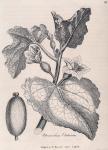043. Momordica elaterium. Wild, or Squirting cucumber.

 Synonyma. Cucumis agrestis. Pharm. Lond.
Synonyma. Cucumis agrestis. Pharm. Lond.
Cucumis asininus. Gerard Emac. p. 912.
Cucumis sylvestris asininus dictus. Bauh. Pin. 314.
Cucumis sylvestris sive asininus. J. Bauh. i. p. 248. Raii. Hist. p. 647.
Cucumis agrestis sive asininus. Park. Theat. 161.
(greek) Graecorum.
Succus fructus inspissatus, Elaterium dictus.
Class Monoecia. Ord. Syngenesia. Lin. Gen. Plant. 1090.
Ess. Gen. Ch. Masc. Cal. 5-fidus. Cor. 5-partita. Filamenta 3.
Fem. Cal. 5-fidus. Cor. 5-partita. Stylus 3-fidus. Pomum elastice dissiliens.
Spec. Char. M. pomis hispidis, cirrhis nullis.
The root is annual, long, thick, and of a fleshy substance; it sends forth several stems, which are round, branched, thick, rough, and trailing like the common cucumber, but without tendrils: the leaves are irregularly heart-shaped, slightly sinuated, veined, above of a deep green colour, underneath paler, rough, reticulated, and stand upon strong footstalks: the flowers proceed from the base of footstalks of the leaves, and are both male and female on the same plant: the corolla is divided into five acute segments, reticulated with green veins, and placed above the germen: the calyx consists of five narrow acute segments: the stamina, in the male flowers, are three, short, tapering, two of which have cloven antherae, the other has a simple one; in the female flowers the filaments are very short, and without antherae: the style is short, trifid, and terminated by oblong stigmata, of a green colour: the fruit is large, oblong, hairy, divided into three cells, which contain many flat seeds: when ripe this fruit, on being touched, bursts open with great force, and throws its contents to a considerable distance; hence the name Squirting Cucumber. It is a native of the South of Europe, and flowers in June and July.
Since the time of Gerard, the wild cucumber has been regularly cultivated in this country for medical use: all the parts of the plant are bitter, and strongly purgative, [Radicum vis cathartica maior est quam foliorum, minor vero quam fructuum. Geoff.] but the dried juice, or faeculae of the fruit, known in the shops by the name of Elaterium, is the only part now medicinally employed, and has been distinguished into white and black Elaterium: the first is prepared from the juice, which issues spontaneously, and the latter from that which is obtained by expression. [This drug was formerly prepared in several different ways, a circumstance necessary to be attended to in the history of its medicinal effects.] The method directed in the London Pharm. for preparing this medicine, is as follows:—"Slit ripe wild cucumbers, and pass the juice (very lightly pressed) through a very fine sieve into a glass vessel; then set it by for some hours, until the thicker part has subsided. Pour off the thinner part swimming at the top, and separate the rest by filtering; cover the thicker part which remains after filtration, with a linen cloth, and dry it with a gentle heat."
The sensible qualities of this inspissated juice are not remarkable either to the smell or to the taste; it is inflammable, and dissolves readily in watery or spirituous menstrua. Elaterium is a very powerful cathartic, and was frequently employed as such both by the Greek and Arabian physicians, and its use has since been much commended in hydropic cases, particularly by Pauli, [Although S. Pauli employed this medicine with great success, yet from the extreme violence of its operation, he thinks it should not be used until the milder purgatives have failed.] Sydenham, [Elaterium sive faecula Cucumeris agrestis, potenter, in permodica quantitate vires suas exserit, in conturbanda alvo, & faecibus, cum serosis & aquosis humoribus copiose egerendis," &c. Op. p. 488.] and Lister. [We may also notice, that Lister observes that the patients, by taking this medicine, became very hot, and found unusual strong pulsations at the extremities of their fingers. De Hydrope, in App. Op. Mortoni, p. 25.] It is undoubtedly the most violent purgative in the Materia Medica, and ought therefore to be administered with great caution, and only where the milder cathartics have proved ineffectual. The dose is from half a grain to three grains: the most prudent and effectual way in which dropsies are now treated by this remedy, is by repeating it at short intervals in small doses.

